Main menu
Common skin conditions

NEWS
Join DermNet PRO
Read more
Quick links
Sunburn — extra information
Introduction
Causes
Demographics
Clinical features
Treatment
Long-term consequences
What is sunburn?
Sunburn is erythema and oedema from excessive exposure to the sun’s rays, more specifically the ultraviolet (UV) radiation emitted from the sun. Sunburn may also occur from exposure to other UV light sources such as in a solarium or tanning salon.
At a cellular level, sunburn is associated with microscopic changes in the skin. There is the formation of UV-induced sunburn cells and a reduction in Langerhans cells and mast cells, which play an essential part of the body's immune defence system.
What causes sunburn?
To better understand the causes of sunburn we need to take a look at some basic principles of the electromagnetic (light) spectrum. This spectrum is divided according to wavelength into the ultraviolet (< 400 nm), visible (400–760 nm), and infrared (> 760 nm). The ultraviolet (UV) spectrum is divided into three broad areas:
- Ultraviolet A (UV-A) = 320–400 nm
- Ultraviolet B (UV-B) = 290–320 nm
- Ultraviolet C (UV-C) = < 290 nm.
UV-C radiation is filtered out or absorbed in the outer atmosphere so does not pose a problem to humans. UV-A and UV-B radiation are the primary causes of sunburn. The skin reacts differently to each waveband.
Reactions to UV-A and UV-B radiation
UV-A |
UV-B |
|---|---|
Less potent than UV-B but is the wavelength that reaches the surface of the earth most (about 90% at midday) Penetrates the middle skin layer (dermis) and subcutaneous fat causing damage to the site where new skin cells are created Long-term exposure causes injury to the dermis resulting in ageing skin |
Much more potent at causing erythema About 90% is absorbed by the surface skin layer (epidermis) Epidermis responds by releasing chemicals that cause the reddening and swelling characteristic of the early signs of sunburn Repeated exposure causes injury to the epidermis resulting in ageing skin |
Who is at risk of sunburn?
Skin phototyping categorises people into one of six groups based on baseline skin colour and the tendency to tan and burn when exposed to UV radiation.
Skin Phototype |
Typical Features |
Tanning ability |
MED (mJ/cm2) |
|---|---|---|---|
I |
Pale white skin, blue/hazel eyes, blond/red hair |
Always burn do not tan |
15-30 |
II |
Fair skin, blue eyes |
Burn easily, tan poorly |
25-40 |
III |
Darker white skin |
Tan after the initial burn |
30-50 |
IV |
Light brown skin |
Burn minimally, tan easily |
40-60 |
V |
Brown skin |
Rarely burn, tan darkly easily |
60-90 |
VI |
Dark brown or black skin |
Never burn always tan darkly |
90-150 |
People with type I skin phototyping are at much greater risk of sunburn than their type VI counterparts. The amount of UV radiation, measured in energy per unit area, to produce erythema at an exposed site is called the minimal erythema dose (MED), and this is significantly lower in people with a low skin phototype grading. Fifteen minutes of midday sun exposure may cause sunburn in a white skin person, while a darker skinned person may tolerate the exposure for hours.
Other factors that increase the incidence of sunburn include:
- Regions situated closer to the equator
- Areas at high altitude – UV radiation increases 4% for every 300m increase in elevation
- Skin exposure between 10 am, and 2 pm – 65% of UV radiation reaches the earth between these times
- Clear skies: clouds and environmental pollution reduce UV radiation
- Environmental reflection – UV radiation is 80% reflected by snow and ice
What are the clinical features of sunburn?
The signs and symptoms of sunburn differ according to the skin phototype and length of exposure to UV radiation.
Signs and symptoms usually occur 2-6 hours after exposure and peak at 12-24 hours; they may include:
- Erythema (redness)
- Oedema (swelling)
- Tenderness and irritation
- Skin feels hot to touch
- Pain
- Blistering (severe cases)
- Chills and fever (severe cases)
In severe cases of sunburn, severe skin burning may result in second-degree burns, dehydration, electrolyte imbalances, secondary infection, shock or even death.
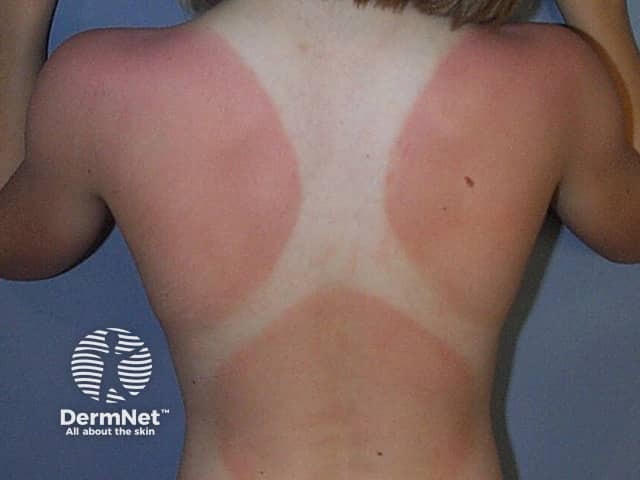
Type 2
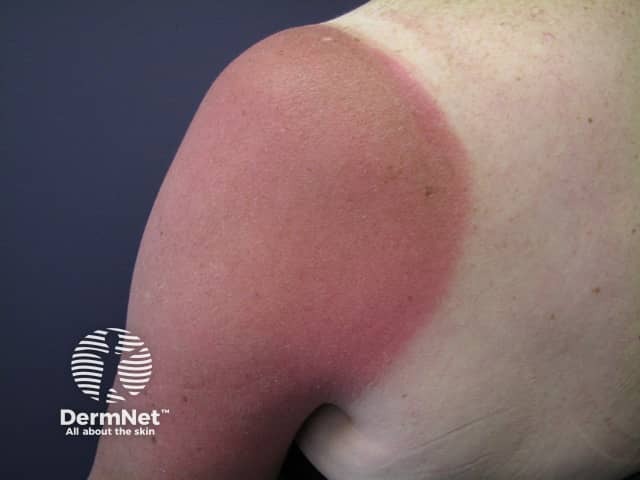
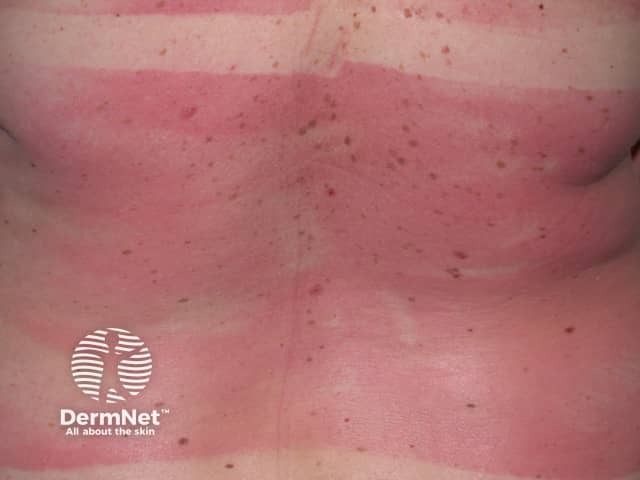
Around 4-7 days after exposure skin may start to peel and flake off.
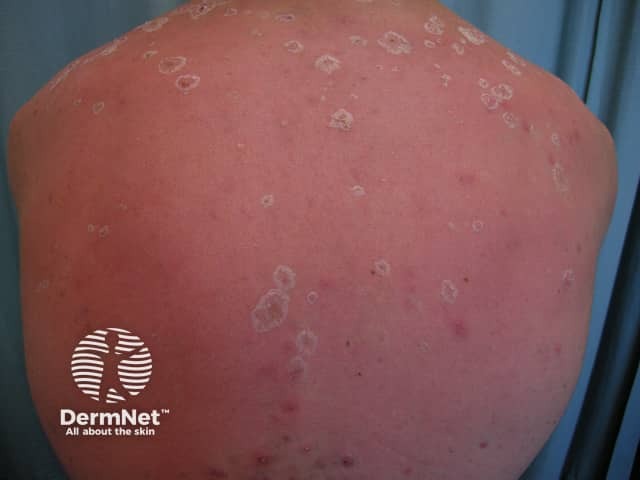
Peeling after sunburn

Peeling after sunburn
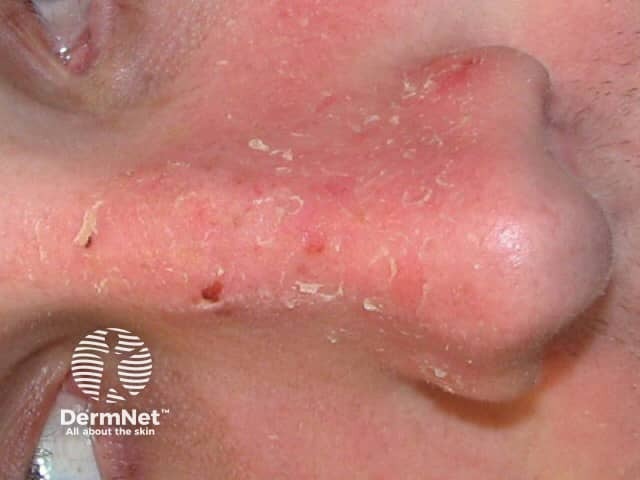
Peeling after sunburn
What is the treatment of sunburn?
The treatment of sunburn is to provide relief of the discomfort it can cause with the use of analgesics (pain-killers), cool baths, aloe vera lotions and moisturisers.
However, sunburn is better prevented than treated. Sun protection is your best defence against sunburn and other damaging effects of UV radiation.
- Avoid sun exposure, especially between 10 am to 2 pm
- Wear protective clothing, including wide-brimmed hats
- Apply and re-apply sunscreen with a Sun Protection Factor (SPF) of 50+
An oral food supplement containing Polypodium leucotomas may provide additional oral photoprotection and reduce sunburn.
If you are inadvertently exposed and expect to be sunburned, you may lessen the severity of the burn with the following measures:
- Take two aspirin immediately and then two every four hours
- Apply a topical steroid to exposed areas twice daily for two or three days
- Take a single high dose of vitamin D3 (100,000 to 200,000 IU) within hours of exposure.
What are the long-term consequences?
It is now clear the long-term consequences of overexposure to the sun or other sources of UV radiation are significant. One blistering sunburn at least doubles the likelihood of developing skin cancer later.
- Premature skin ageing and wrinkling
- Brown spots and freckles (lentigines)
- Development of premalignant lesions (actinic keratoses)
- Development of skin cancer (eg, melanoma, basal cell carcinoma, squamous cell carcinoma)
References
- Book: Textbook of Dermatology. Ed Rook A, Wilkinson DS, Ebling FJB, Champion RH, Burton JL. Fourth edition. Blackwell Scientific Publications.
- McGrath JA, Lu KQ. Single high-dose vitamin D3: a promising sunburn therapy. Br J Dermatol. 2025;192(2):181-182. Journal
On DermNet
- Phototesting
- Ageing skin
- Sun protection
- Sun protective clothing
- Skin cancer
- Skin phototyping
- Sunscreens
- Thermal burns
- Blistering skin conditions
- Ultraviolet radiation
Other websites
